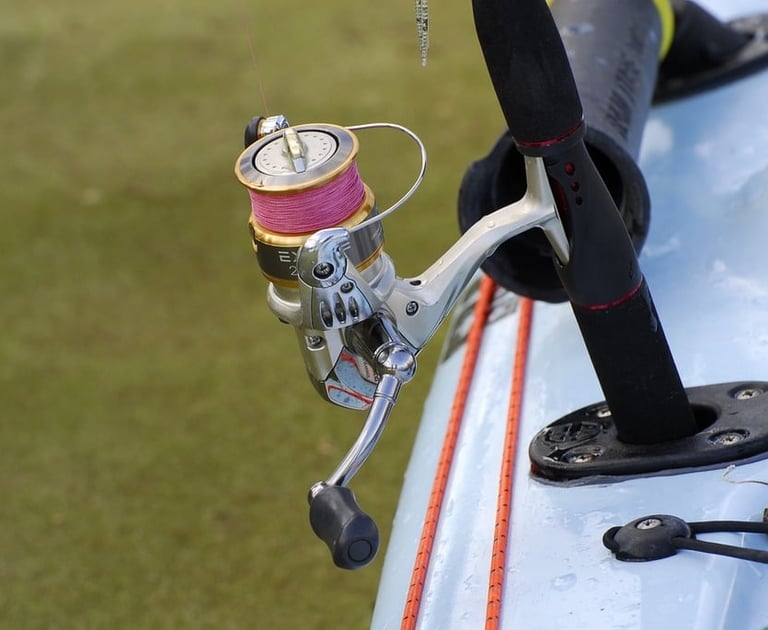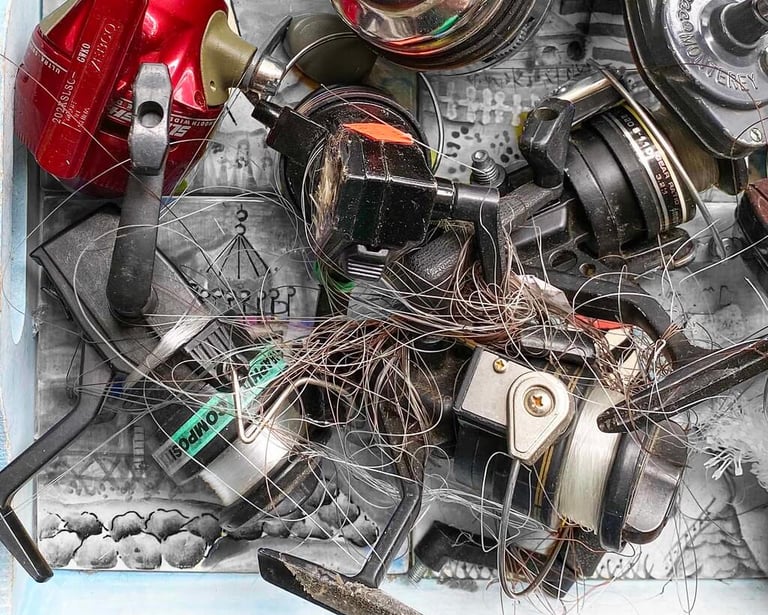How to Choose the Right Fishing Line
Learn how to choose the right fishing line with our expert guide. Discover different types, strengths, and materials to match your fishing style and target species for better catches
FISHING LINE
Z-men
12/4/202411 min read


Are you new to fishing and unsure which type of line to use? Or maybe you're an experienced angler looking to upgrade. Choosing the right fishing line is key to success on the water. There are three main types: monofilament, fluorocarbon, and braided, each with its own benefits.
This guide will help you pick the perfect line for your fishing needs. It's not as hard as it seems.
Understanding Fishing Line Basics
Choosing the right fishing line is key for a great fishing trip. A good line balances strength, sensitivity, and durability. Knowing the fishing line buying guide is vital.
What Makes a Good Fishing Line
The material, diameter, strength, and visibility of a line affect its performance. Monofilament lines are flexible and simple to use. Fluorocarbon lines are almost invisible underwater.
Braided lines have high strength and sensitivity. They're perfect for lure fishing and feeling the bottom.
Key Factors in Line Selection
When picking a line, think about the fish you're after, the water, and your fishing style. The line's stretch, abrasion resistance, and knot strength matter a lot. Knowing the different types of fishing line helps you choose wisely.
Line Properties That Matter
Line features like stretch, memory, and visibility are important. Monofilament lines absorb shock well. Fluorocarbon lines are almost invisible underwater.
Braided lines are strong and sensitive. They're a favorite for many fishing tasks.


Types of Fishing Line Materials
Fishing lines come in three main types: monofilament, fluorocarbon, and braided. Monofilament is a single nylon strand. Fluorocarbon is made from polyvinylidene fluoride. Braided line is woven from polyethylene fibers. Each type suits different fishing needs.
Monofilament is the cheapest and easiest to handle, great for beginners. But, it weakens in sunlight and absorbs water, affecting its performance. Braided line, though pricier, offers strength and sensitivity. It's perfect for those who want to cast far and last longer.
Fluorocarbon is known for its toughness and almost invisible underwater. It's ideal for fishing in dense cover or when fish are shy. It's stiffer, better for hard sets, but can be more expensive than monofilament.
Copolymer lines are a newer option. They're stronger than monofilament and more affordable. They're good for all skill levels but may not last long in sunlight. They're not the best for fishing on the surface.
The right fishing line depends on the fishing conditions, the fish you're after, and your skill level. Knowing the strengths and weaknesses of each line helps anglers choose the best for their success on the water.
Monofilament Fishing Line: Pros and Cons
Monofilament is a top pick for beginners in fishing. It's affordable and versatile, making it perfect for new anglers. This line stretches well and is hard to see underwater.
Advantages of Monofilament
Monofilament is cheap, which is great for beginners. It works well in shallow water, letting you see your bait. It's not as sensitive as other lines but is good for visible fishing.
When to Use Monofilament
Beginners will find monofilament easy to use and reliable. It's strong at knots and resists wear, making it good for hooks. Its stretch helps when landing big fish, reducing breakage.
Cost and Durability Factors
Monofilament can break down from UV rays and water, needing more replacements. But, its low cost makes it a favorite for those watching their budget. It's a solid choice for best fishing line for beginners.
Fluorocarbon Lines: Advanced Features
Fluorocarbon lines are a top pick for bass fishing. They are almost invisible underwater, perfect for clear water. This makes them great for sneaking up on bass without being seen.
Fluorocarbon lines also have less stretch than monofilament. This means you can feel even the smallest bites. It's a big plus when you're fishing for wary bass.
Fluorocarbon lines sink fast because they're denser than water. This is great for finesse techniques and fishing near structures. But, they can be pricier and may hold memory, leading to tangles. With the right care, a fluorocarbon line can last a long time, up to 4 times longer than monofilament.
Choosing the right fluorocarbon line is key. Look at the pound-test, knot strength, and how you plan to use it. Lines range from 4 to 30 pounds, fitting different fishing styles. The Palomar knot is best for fluorocarbon lines. Brands like Seaworx Fishing Gear and Vicious Fishing make high-quality lines that bass anglers love.
Braided Fishing Lines: Strength and Sensitivity
Anglers looking for top-notch strength and sensitivity should check out braided lines. These lines have a great strength-to-diameter ratio. This means you can use thinner lines that are very strong.
One big plus of braided lines is their minimal stretch. This gives anglers great sensitivity. They can feel even the smallest bites and the shape of the underwater world.
Benefits of Braided Lines
Braided fishing lines are known for their durability and resistance to abrasion. They're perfect for fishing in heavy cover, deep water, or with big fish. Their lack of memory and resistance to coiling makes casting and reeling smooth.
Also, braided lines are a good value because they last a long time. This means you get a lot of use out of them, saving you money in the long run.
Best Applications for Braided Line
Braided lines are versatile and work well in many fishing situations. They're great for deep-water fishing because of their sensitivity and strength. They help anglers detect bites and land big fish.
They also perform well in heavy cover, like around plants or rocks. Their abrasion resistance and hook-setting power are key here. Plus, braided lines are perfect for long-distance casting. They give anglers the range and accuracy they need.


How to Choose Fishing Line for Different Situations
Choosing the right fishing line is key. Think about the water, the fish you're after, and your fishing style. For clear water, use fluorocarbon or light monofilament lines. They're less visible to fish.
In thick cover or grass, go for a braided line or a heavier monofilament. This helps your line handle the roughness.
Make sure your line fits your reel's needs. Check the line capacity and test strength. For finesse fishing, like drop-shotting, use a light line. It keeps your line sensitive.
For power fishing, like pitching, a heavier line is better. It can handle the extra strain.
There's no single line for all fishing. Know the strengths of each line type. Choose the best one for your fishing. This way, you'll catch more fish and have a better time fishing.
Matching Line Strength to Your Target Species
Choosing the right fishing line is key. It depends on the species you're after and where you fish. The line's strength, or "pound test" (lb test), shows how much weight it can handle before breaking. It's vital for both freshwater and saltwater fishing.
Freshwater Fish Requirements
For bass, a 6-12 lb test line works well. Trout fishing might need a lighter 2-6 lb test line. The size of the spool matters too, as smaller reels fit lighter lines better.
Some anglers aim to catch trout with just 2 lb test lines. This makes it harder to land the fish, but it's a challenge.
Saltwater Fishing Considerations
Saltwater fishing calls for stronger lines due to bigger fish and tougher conditions. Lines ranging from 15-80 lb test or more are common. For inshore fish like redfish, snook, or trout, 10-20 lb test lines are good.
Offshore, for tuna, marlin, or grouper, you'll need 50-100 lb test or more. Braided lines are great for saltwater because they resist abrasion well. They're perfect for areas with sharp rocks or coral reefs.
Choosing the right line strength is critical. Think about your target species, the fishing spot, and your tackle. This ensures you have the best line for your fishing strategy.
Understanding Line Weight and Test Ratings
Choosing the right fishing line means knowing about line weight and test ratings. Line weight is how thick or thin the line is. The test rating shows how much force it takes to break the line.
The test rating is in pounds. It's key to match the line test with your rod and reel for the best results. The actual breaking strength can differ from the test rating due to knots and line condition.
To find the right test weight, look at fishing line strength charts. These charts compare different brands and types. They help you pick the right line test for your fish, fishing style, and where you fish.
Remember, line weight and test rating aren't the same. A thicker line might be stronger but could affect how far you can cast and how sensitive it is. Think about what you need for your fishing trip when picking the perfect line.
Fishing Line Color Selection Guide
The color of your fishing line can greatly affect your success. Anglers know that line visibility is key, both above and below water. The right line color can help you see it better and make it less visible to fish.
Visibility in Different Water Conditions
Clear and blue lines are hard to see in clear water. Green lines work well in areas with lots of vegetation. For fishing in low light, fluorescent colors help you see your line better.
While some debate if fish notice line color, choosing a less visible line can boost your confidence. This might lead to more bites.
Color Impact on Fish Behavior
Some line colors affect fish behavior more than others. Inshore saltwater fishing does well with bronze and green lines. These colors blend well with the environment. Offshore fishing benefits from high-visibility lines. They help you tell your rods apart during hookups.
Choosing the right fishing line color is about seeing it well and being stealthy. Try different colors and see how fish react in different situations.


Line Memory and Management Tips
Fishing line memory can cause tangles and shorten your casting distance. It happens when the line keeps its coils from being spooled. To fix this, using line conditioners, like for fluorocarbon lines, can help. Also, proper spooling and replacing the line often can reduce memory issues.
Anglers using braided lines should consider adding a monofilament or fluorocarbon backing. This prevents slippage and keeps the line in good shape. It also helps avoid why does my fishing line keep breaking? or how to avoid fishing line tangles.
Knowing the differences in fishing line materials can help manage memory. Monofilament lines, for instance, have more memory than fluorocarbon or braided lines. Trying out different lines and spooling methods can help you find what works best for you.
Weather and Environmental Considerations
Anglers understand how weather and environment affect our fishing lines. Temperature is key when picking the right line for fishing.
Temperature Effects on Fishing Line Performance
In cold weather, lines get stiffer and harder to cast. In hot weather, lines might break more easily. Choosing the right line for the season is important.
Adapting to Water Conditions
The water you fish in also matters. In murky water, you can use stronger lines. But in clear water, choose lines that are less visible, like fishing line tips for casting longer distances.
Proper Line Maintenance and Storage
Keeping your fishing line in top shape is key for great performance and longer life. Protect it from the sun and other environmental factors. UV rays can weaken the line over time.
After fishing in saltwater, rinse your line with fresh water. This removes salt and debris. Regular checks for wear, like fraying, are also vital. Replace the line if you find any damage.
Using line conditioners can also help. They reduce memory and improve your casts. When storing rods and reels, back off the drag. This prevents strain on the line.
For those who spool reels from bulk, proper storage is essential. Use waterproof containers and silica gel packs to keep moisture out. A large waterproof box, like the Plano XL Dry Storage 1812, is great for storing bulk spools.
By following these tips, your fishing line will perform better. A little care goes a long way. It improves your casts, sensitivity, and reliability on the water.
Common Fishing Line Problems and Solutions
Fishing line can face many issues, like tangles, twists, abrasion, and wear. It's important to prevent these problems for a great fishing experience. Knowing how to tackle these issues with the right line is key.
Preventing Line Tangles
Line tangles are a big problem for anglers. They happen when there's slack in the line or the wrong line type for your reel. To avoid tangles, keep a tight line while reeling and pick a line that fits your reel well.
Braided or heavy fluorocarbon lines are great for heavy cover. They resist abrasion and are sensitive, helping you avoid snags.
Dealing with Line Wear
Over time, fishing line can wear out, losing strength and performance. To fight line wear, use a leader in abrasive areas and change your line often, if you fish in heavy cover. Check your line's condition often.
If it looks frayed, brittle, or has been on the reel for over a year, it's time for a new one. High-quality, abrasion-resistant lines like braided or heavy fluorocarbon can last longer in tough conditions.
Budget Considerations and Value Analysis
Choosing the right fishing line can be tricky for beginners. They might think the cheapest option is best. But, looking at the long-term value shows that better lines are worth the extra cost.
Premium fishing lines might cost more upfront. But, they last longer and perform better. This makes them a smarter choice in the long run.
How often you go fishing matters. If you fish a lot, spending more on a quality line is wise. These lines last longer and work better, making the extra cost worth it.
But, if you fish less often, a good monofilament line might be better. These lines are cheaper and reliable. They're great for beginners who don't need fancy features.
By thinking about cost, lifespan, and performance, you can find the best value. This helps you choose a fishing line that fits your needs and budget.
Conclusion:
Choosing the right how to choose fishing line is about more than just picking a line. It's about your fishing style, the fish you're after, and where you're fishing. Each type of line has its own strengths and weaknesses.
Monofilament offers stretch and buoyancy, while fluorocarbon is great for hiding from fish and standing up to abrasion. Braided lines are strong and sensitive. Trying out different lines can help you find the best one for you.
Good line selection is key to catching fish. It's not just about the line itself, but also how well it matches your gear and technique. As you learn more about how to choose fishing line, be ready to change your approach. This will help you catch more fish and have more fun on the water.
FAQ:
What are the main types of fishing line?
The main types are monofilament, fluorocarbon, and braided.
What factors should I consider when choosing a fishing line?
Consider strength, visibility, and durability. Also, think about the fishing conditions and your target species.
What are the advantages and disadvantages of monofilament, fluorocarbon, and braided lines?
Monofilament is versatile and affordable. Fluorocarbon is nearly invisible underwater. Braided line is strong and sensitive. Each has its own uses.
When should I use monofilament, fluorocarbon, or braided line?
Use monofilament for beginners and shallow water. Fluorocarbon is best in clear water. Braided line is for deep water and heavy cover.
How do I determine the right line strength for my target species and fishing environment?
Choose a line test that matches your rod and reel. Consider the size of your target species and the conditions. Freshwater species need 6-12 pound test, while saltwater may need 15-80 pound test or more.
How does line color affect visibility and performance?
Line color affects visibility above and below water. Clear, blue, and green lines are less visible. Fluorescent colors are more visible to the angler.
How can I manage fishing line memory and prevent tangles?
Use line conditioners and proper spooling. Replace lines regularly to reduce memory. Avoid slack while retrieving and use the right line for your reel to prevent tangles.
How does weather and temperature affect fishing line performance?
Cold weather makes lines stiffer and more prone to memory. Hot conditions increase the risk of line breakage. Choose your line based on seasonal changes and environmental factors.
How do I properly maintain and store my fishing line?
Store gear away from sunlight. Rinse lines with fresh water after saltwater use. Regularly inspect for wear. Use line conditioners and replace lines as needed to extend their lifespan and performance.
What are some common fishing line problems and how can I solve them?
Common issues include line twist, wind knots, and abrasion damage. Prevent tangles, use leader material in abrasive environments, and replace worn lines to address these problems.

